|
Centropus burchellii (Burchell's
coucal)
Gewone vleiloerie [Afrikaans]; Ubikhwe [Xhosa]; uFukwe,
umGugwane [Zulu]; Mukuku (generic term for cuckoos and coucals) [Kwangali];
Mohofa [South Sotho]; Umfuku [Swazi]; Mfukwana [Tsonga]; Burrchell-spoorkoekoek
[Dutch]; Coucal de Burchell [French]; Tiputip [German]; Cucal de Burchell
[Portuguese]
Life
> Eukaryotes >
Opisthokonta
> Metazoa (animals) >
Bilateria >
Deuterostomia > Chordata >
Craniata > Vertebrata (vertebrates) > Gnathostomata (jawed
vertebrates) > Teleostomi (teleost fish) > Osteichthyes (bony fish) > Class:
Sarcopterygii (lobe-finned
fish) > Stegocephalia (terrestrial
vertebrates) > Tetrapoda
(four-legged vertebrates) > Reptiliomorpha > Amniota >
Reptilia (reptiles) >
Romeriida > Diapsida > Archosauromorpha > Archosauria >
Dinosauria
(dinosaurs) > Saurischia > Theropoda (bipedal predatory dinosaurs) >
Coelurosauria > Maniraptora > Aves
(birds) > Order: Cuculiformes
> Family: Centropidae
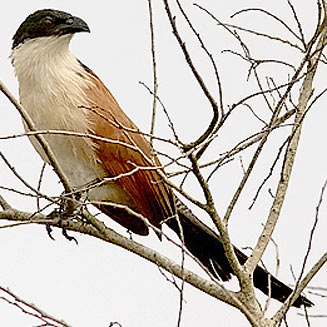 |
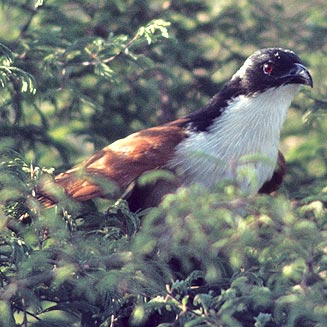 |
|
Burchell's coucal. [photo
Jeff Poklen
©] |
Burchell's coucal. [photo H. Robertson, Iziko
©] |
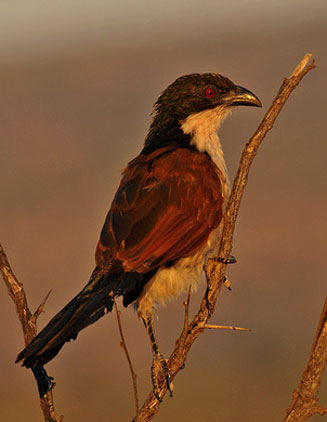 |
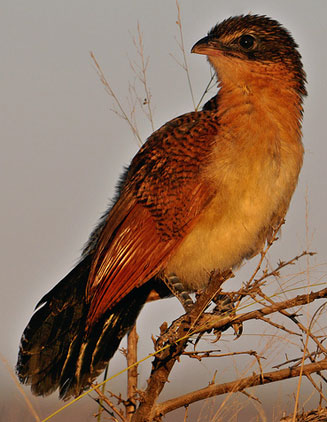 |
|
Burchell's Coucal adult (left) and juvenile
(right), Kruger National Park, South Africa. [photo
Callie de Wet ©] |
The Burchell's coucal is endemic, being found
mainly in South Africa, living in a wide variety of habitats. It is a voracious
predator, feeding on small birds, mammals, reptiles and insects. Interestingly,
the male does more work than the female, building the nest, incubating the eggs
and doing most of the hunting. The chick's feet develop quickly, and they are
capable of clambering around bushes long before they can fly. They usually leave
the nest at 21 days old, after which they are still dependent on their parents
for weeks.
Distribution and habitat
Near-endemic to southern Africa, occurring from
north-eastern Mozambique and southern Malawi to northern Namibia,
northern and south-eastern Botswana, Zimbabwe, Mozambique, Swaziland and eastern
and southern South Africa. It generally prefers areas with dense vegetation and at least 600 mm of rainfall per year, such as
thickets, reedbeds, coastal bush, borders between woodland and grassland and
land adjacent to vleis.
|
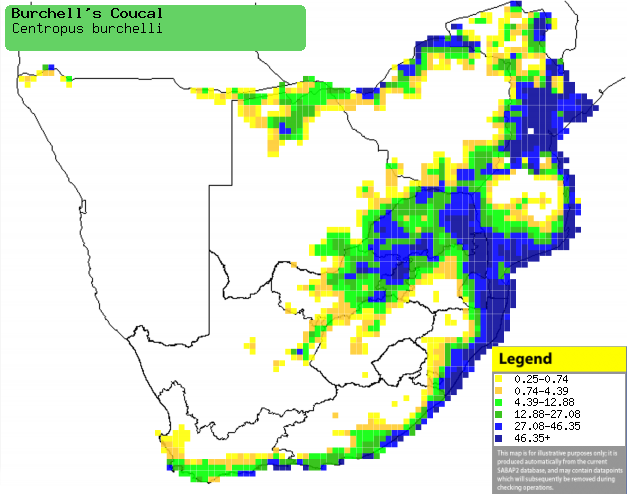 |
|
Distribution of Burchell's coucal in southern Africa,
based on statistical smoothing of the records from first SA Bird Atlas
Project (©
Animal Demography unit, University of
Cape Town; smoothing by Birgit Erni and Francesca Little). Colours range
from dark blue (most common) through to yellow (least common).
See here for the latest distribution
from the SABAP2. |
Food
A voracious predator, it feeds
mainly on small animals, rarely eating fruit. It does most of its foraging in bushes
and trees, often flying down to the ground to catch prey. The following food
items
have been recorded in its diet:
- Invertebrates
- Vertebrates
- birds
- mammals
- reptiles
- amphibians
- Fruit
- Eriobotrya japonica (Loquat)
- Ziziphus mucronata (Buffalo-thorn)
Breeding
- The male builds the nest, which is a large, scruffy collection of grass
and leaves, shaped into a deep cup. It is placed 0.5-10m above ground, in a
large grass tuft, reedbed, thicket, creeper, bush, hedge or thorny tree.
- Egg-laying season is from September-March, with slight variations with
different regions.
- It lays 2-5 eggs, with an interval of 1-2 days between the laying of
each egg.
- Incubation is done mostly by the male for about 15-16 days.
- The chicks' feet develop quickly, and they are capable of clambering
around bushes long before they can fly. They usually leave the nest at 21
days old, after which they are still dependent on their parents for many weeks.
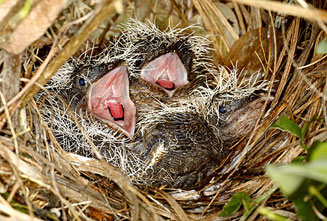 |
|
|
Burchell's coucal nestlings, Modimolle, South
Africa. [photo Warwick Tarboton ©] |
|
Threats
Not threatened.
References
-
Hockey PAR, Dean WRJ and Ryan PG (eds) 2005. Roberts
- Birds of southern Africa, VIIth ed. The Trustees of the John Voelcker
Bird Book Fund, Cape Town.
|
